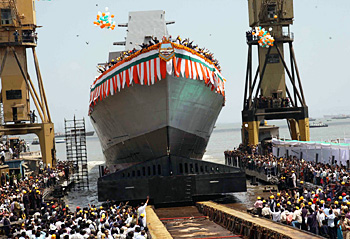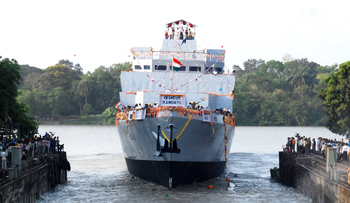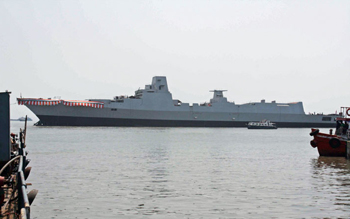INDIAN ARMED FORCES CHIEFS ON
OUR RELENTLESS AND FOCUSED PUBLISHING EFFORTS

SP Guide Publications puts forth a well compiled articulation of issues, pursuits and accomplishments of the Indian Army, over the years

I am confident that SP Guide Publications would continue to inform, inspire and influence.

My compliments to SP Guide Publications for informative and credible reportage on contemporary aerospace issues over the past six decades.
- Prime Minister witnesses 'Bharat Shakti' – a Tri-Services Firing and Manoeuvre Exercise in Pokhran, Rajasthan
- Interim Defence Budget 2024-25 — An Analysis
- Union Defence budget 2024
- Prime Minister Modi Commemorates Indian Navy Day in a Grand Ceremony
- Prime Minister Modi Flies in the LCA Tejas
- New Chapter in India-Italy Defence Ties
- Airpower beyond Boundaries
World Waits For 2 New Frontline Indian Warships



The INS Kolkata has sparked worldwide interest for a variety of reasons, not least because it is the most complex indigenously designed, developed and built frontline warship to enter Indian service. 163 metres long, propelled by four gas turbines, it is designed to achieve speeds in excess of 30 knots. The indigenously designed ship, currently drydocked after undergoing final sea trials in the Arabian Sea, sports advanced weapons and sensors, stealth features, an advanced action information system, a comprehensive auxiliary control system, world-class modular living spaces, sophisticated power distribution system and a host of other advanced features. The destroyer class, certain to be the Navy’s pride after the formidable Delhi class of guided-missile destroyers, comes integrated with the supersonic BrahMos anti-ship and land attack missile system, enabling the ship to engage shore-based and naval surface targets at long range. The ship’s air defence capability, designed to counter the threat of enemy aircraft and anti-ship cruise missile will revolve around the vertical launch, longrange surface to air missile system, which is being co-developed by the Defence Research and Development Organisation (DRDO). Four AK-630 rapid-fire guns provide the ship with close-in defence capability while a medium-range gun will enable her to provide effective naval gunfire support. Indigenously developed twin tube torpedo launchers and rocket launchers will add punch to the ship’s anti-submarine capability.
The Directorate of Naval Design is proud of the Kolkata class. A top official with the department tells SP’s, “The P15A destroyer adds a new dimension in naval warfare for the Indian Navy. The ship will have modern weapons and sensors, advanced action information system, total atmospheric control system and a host of other advanced features. These ships with updated weapon package and new look exteriors for improved stealth will transform surface warfare. The navy is excited on the follow-on four Project 15B improved Kolkata class destroyers.”
Just as anticipated is the lead ship of the Project 28 Kamorta class of four anti-submarine warfare corvettes. With an aim of 90 per cent indigenisation in the class’s manufacture at the Garden Reach Shipbuilders and Engineers Ltd (GRSE) shipyard in Kolkata, efforts made by the Indian Navy towards its national goal of indigenisation and self-reliance isn’t just a castle in the air. The brand new ASW platforms will stealthily seek and destroy lurking enemy submarines. While the Kamorta will enter service next month, the remaining three ships are to be delivered progressively until 2016. The Kamorta class corvettes also mark many firsts including introduction of the ‘rail-less helo traversing system’ to handle a helicopter on board the ship, foldable hangar door, use of indigenous DMR 249A steel and carbon fibre reinforced plastic (CFRP) superstructure integrated with the steel hull of the ship. Besides reducing the overall top weight, this provides the ship with improved stealth features and reduces life cycle maintenance costs. The ship’s hull form is efficient with excellent sea-keeping and manoeuvrability characteristics having an overall length of 109 metres. The ship can cut through the sea at a very high speed of 25 knots. Hull of the ship is built with warship grade high tensile indigenous steel. The ship’s advanced stealth features will make her less susceptible to detection and help in effective deployment of soft kill measures. The ships will be fitted with complete indigenous state-of-the-art weapons and sensors, including a medium-range gun, torpedo tube launchers, rocket launchers and close-in weapon system. These ships are also equipped with a bow-mounted sonar and are capable of deploying a helicopter, adding considerable punch to the ship’s anti-submarine capability. These ships also feature an advanced Integrated Platform Management System for controlling and coordinating the propulsion, auxiliary and power generation equipment.





